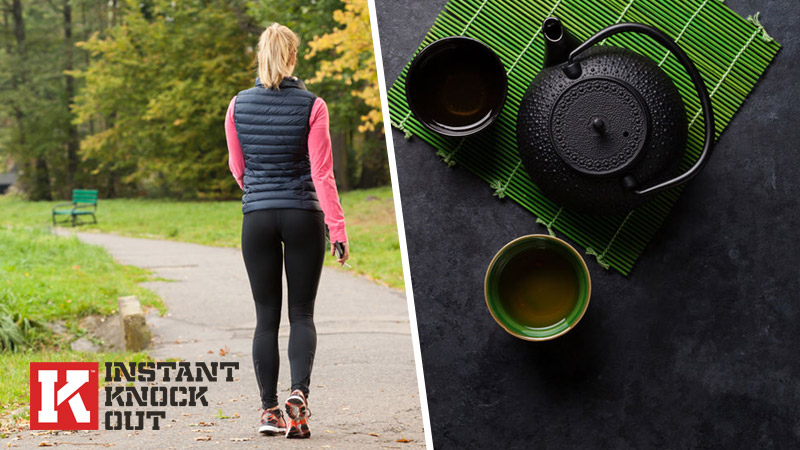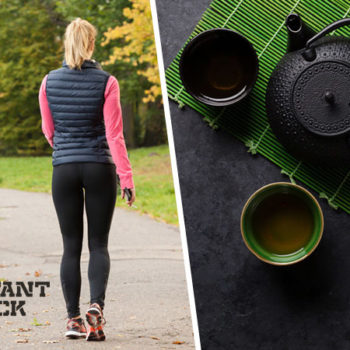Best Home Remedies to Lose Weight Fast Without Exercise

When it comes to shredding fat and toning up your physique naturally, there are many people that struggle to reach their goals.
The temptation to stray from your diet or the lack of time to hit the gym can sooner or later get the better of you.
With your busy lifestyle and endless hours at work it’s pretty much impossible to get going with an exercise plan right now – and now you’re concerned that you’re going to be just another statistic when it comes to failed weight loss journeys.
But there are lots of ways to shred fat and lose pounds without exercising, and each can make it easier to stick to the plan.
In this article we look at exactly how you can lose weight using simple, easy-to-action home remedies.
Calories, Fat Loss and Diet Success
Before we take a look at the home remedies you can use to help you lose weight, it is important to frame this article with some context.
The most important part of any successful weight loss journey is energy balance.
If you aren’t taking in less calories than you’re putting in your body each day, you just won’t lose the fat. It’s a law of thermodynamics that you just can’t escape unfortunately.
But once you achieve a calorie deficit and enter a negative energy balance, the magic begins to happen – your fat cells allow fatty acids to separate from their glycerol component, and as such they can then be burned for fuel.
When you are using more than you taking in, your body draws on stored fat to convert it to energy. And when this happens, your the fat cells in your body shrink and you lose inches and fat mass.
The result? Less fat and a better body composition.
If you don’t achieve your deficit? Your fat cells just won’t part with their fatty goodness.
That said, there are a number of home remedies, hints and tricks that you can use to either help you reach negative energy balance; or speed up fat loss once you’re there.
Here they are…
#1. Track Your Calories
If you don’t track your calorie intake how, do you know whether you’re hitting your energy deficit or not?
Well, you don’t.
And the process is simple – use a calorie calculator like the one below and the built-in algorithm will do the rest.
Once you know exactly how many calories you can take in each day and still lose weight you’ll feel much happier with what you can and can’t eat. And this makes it much more likely that you’ll shred fat than if you were to leave things to chance by not tracking [1].
If you record what you eat you’re much more likely to eat less as well – perfect if you’re on a calorie-controlled eating plan [2].
#2. Drink Green Tea
One of the most potent homemade weight loss remedies is green tea.
As a natural beverage with potent antioxidant and anti-inflammatory properties, green tea contains a number of fat-fighting compounds. These include polyphenols and catechins – the most relevant here being epigallocathechin-3 gallate (EGCG).
You’ll also get a great energy boost from the 15-60 mg of natural caffeine in each cup as well.
Studies show that green tea is great for weight loss. It can increase energy expenditure through a process called thermogenesis, even when in a calorie deficit [3].
It can also increase the rate at which you oxidize fat too, by as much as 16% [4]. Basically, it helps you liberate fat energy from your cells and use it as fuel – the key to a healthy body composition.
#3. Add Spice to Your Food
Healthy eating to lose weight doesn’t have to be repetitive or bland – especially when you decide to spice things up in the kitchen.
The most popular of spices for example – black pepper – is high in fiber, vitamins and minerals. It is a potent anti-inflammatory and gastrointestinal health regulator.
Pepper contains a bioactive compound called piperine. And it is this thermogenic ingredient that provides the home remedy because it can inhibit proteins called PPARy and LXRa – both of which regulate genes involved in adipose cell growth.
Piperine also suppresses fat cell size and triggers an increase in metabolic rate by switching on fat receptors sites as well [5].
And if you’re feeling a little more adventurous, chili peppers to your meals can help to reduce calorie intake and reduce appetite too due to its powerful compound capsaicin [6, 7].
#4. Drink Plenty of Water
Probably the easiest weight loss home remedy to fit into your busy lifestyle is to drink more water. It really can be the key to shredding more fat during a weight cut.
Drinking as little as 500 ml of water prior to a meal can boost metabolic rate by as much as 30% [8].
And other studies have shown that regularly drinking this essential nutrient for a 12-week period can lead to an extra 2 kg weight loss too [9].
Compared to other drinks such as fruit juice and soda, there really is no better remedy for weight loss.
#5. Boost Non-Exercise Activity Levels
Whilst structured exercise sessions might be out of the question right now, there is another way that you can burn calories – and you can integrate it into your daily routine too.
Every time you move your body you burn energy, no matter how low the intensity might be.
Non-exercise activity thermogenesis (NEAT) refers to any activities that aren’t structured. It’s any energy burned that isn’t from sports, exercise or sleeping.
Dancing whilst doing the ironing, playing soccer with the kids or jogging up the stairs each time you get back to your apartment are all quick fixes for squeezing out some extra calorie burning.
At only a few calories per minute, NEAT might not seem like a potent weight loss home remedy, but studies show that those who have higher non-exercise activity levels also have healthier body masses too [10].
#6. Take a Supplement
A high-quality fat burner supplement not only provides you with all of the essential nutrients you need to nourish your body during a cut, it also helps to boost thermogenesis and reduce appetite.
Containing nutrients such as green tea extract, chili pepper and caffeine, fat burners accelerate progress when in a deficit, helping to give you energy, motivation and resilience to get where you need to be.
#7. Add Protein to Each Meal
Protein is the most satiating of the three macronutrients (the others being carbs and fat). This means that protein not only takes longer to digest; it keeps you fuller for longer too.
Because it takes more energy to digest and absorb protein, you can end up expending 100 kcal or more just by adding in protein-based foods into your diet [11].
Some studies have shown that eating meals that are made up of 30% protein can reduce overall energy intake by 441 kcal [12]. And in that particular study, following this procedure for 16-weeks led to weight loss of 4.9 kg and reduced fat mass of 3.7 kg.
#8. Keep Fiber High
A high-fiber diet not only helps you maintain a healthy cardiovascular and digestive system, it can also help to keep you feeling fuller for very few calories.
Soluble fiber is a viscous component of food that swells in your stomach. It helps to increase gut transit and digestion time, helping to curb your appetite and reduce overall calorie intake.
Glucomannan is a soluble fiber found in the konjac plant that has been well-studies for its role in weight loss.
The polysaccharide chain of beta-D-glucose and beta-D-mannose composition of glucomannan has been seen to directly aid in weight loss in a number of clinical trials [13, 14].
#9. Don’t Drink Calories
If there’s one surefire way of going over your daily calorie needs it’s drinking sugary drinks.
The liquid calories you obtain from juices, milkshakes, energy drinks or soda don’t fill you up and can contribute to a big daily calorie surplus without you even realising. And even if you track food, it’s easy to forget to add these into your diary.
Not only are sugary drinks associated with diabetes and other metabolic complications, they can also lead to weight gain.
In one study, 450 kcal of soda on top of a normal diet led to over 15% additional energy intake per day [15] and another reported that when fruit-based drinks were added into the diet of volunteers, body fat went up by over 8% in 10 weeks [16].
#10. Try Fasting
There’s nothing magical about intermittent fasting – the process of fasting in itself doesn’t really help you shred more fat than a traditional diet, but as a home remedy for weight loss it can really help you hit your calorie deficit. And that’s the important bit.
Intermittent fasting is simply structuring your day into periods of fasting and eating – usually based around 16-hour fasts and 8-hour periods where you can eat.
And studies suggest that it is this structured approach that helps you lose weight because it provides you with less of an opportunity to overeat your calories [17].
And before you question whether or not you’ll lose lean mass on a time-restricted diet, don’t. Another study found that combining fasting with strength training helped a group of active men retain lean mass, even during intense fasting [18].
References
- Baciqalupo, R et al. Interventions employing mobile technology for overweight and obesity: an early systematic review of randomized controlled trials. Obes Rev. 2013; 14(4): 279-91
- Burke, LE et al. Self-monitoring in weight loss: a systematic review of the literature. J Am Diet Assoc. 2011; 111(1): 92–102
- Hursel R et al. The effects of green tea on weight loss and weight maintenance: a meta-analysis. Int J Obes. 2009;33:956–61.
- Hursel R et al. The effects of catechin rich teas and caffeine on energy expenditure and fat oxidation: A meta-analysis. Obes. Rev. 2011; 12: e573–e581
- Okumura, Y et al. Adiposity suppression effect in mice due to black pepper and its main pungent component, piperine. Biosci Biotechnol Biochem. 2010; 74(8): 1545-9
- Yoshioka, M et al. Effects of red pepper added to high-fat and high-carbohydrate meals on energy metabolism and substrate utilization in Japanese women. Br J Nutr. 1998;80(6):503-10.
- Whiting, S et al. Could capsaicinoids help to support weight management? A systematic review and meta-analysis of energy intake data. Appetite. 2014; 73: 183-8
- Boschmann, M et al. Water-induced thermogenesis. J Clin Endocrinol Metab. 2003 Dec; 88(12): 6015-9
- Dennis, EA et al. Water consumption increases weight loss during a hypocaloric diet intervention in middle-aged and older adults. Obesity (Silver Spring). 2010 Feb; 18(2): 300-7
- McGuire, KA et al. Incidental physical activity is positively associated with cardiorespiratory fitness. Med Sci Sports Exerc. 2011; 43(11): 2189-94
- Crovetti, R et al. The influence of thermic effect of food on satiety. Eur J Clin Nutr. 1998; 52(7): 482-8
- Birketvedt, GS et al. Experiences with three different fiber supplements in weight reduction. Med Sci Monit. 2005; 11(1)
- Walsh, DE et al. Effect of glucomannan on obese patients: a clinical study. Int J Obes. 1984; 8(4): 289-93
- Weigle, DS et al. A high-protein diet induces sustained reductions in appetite, ad libitum caloric intake, and body weight despite compensatory changes in diurnal plasma leptin and ghrelin concentrations Am J Clin Nutr. 2005; 82(1): 41-48
- DiMeglio, DP et al. Liquid versus solid carbohydrate: effects on food intake and body weight. Int J Obes Relat Metab Disord. 2000; 24(6): 794-800
- Stanhope, KL et al. Consuming fructose-sweetened, not glucose-sweetened, beverages increases visceral adiposity and lipids and decreases insulin sensitivity in overweight/obese humans. J Clin Invest. 2009
- Collier, R. Intermittent fasting: the science of going without. CMAJ. 2013; 185(9): E363-364
- Tinsley, GM et al. Time-restricted feeding in young men performing resistance training: A randomized controlled trial. Eur J Sport Sci. 2017; 17(2): 200-207



